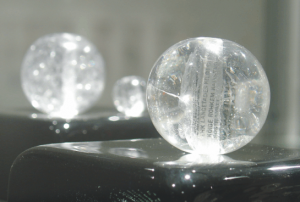 19. 11.2004 – 16.01.2005
19. 11.2004 – 16.01.2005
Estonian Museum of Applied Art and Design
The current exhibition presents some of the chapters from the long and variegated history of glass beads and is the first such a comprehensive introduction of glass beads in Estonia.
 Both the centuries-old and contemporary glass beads, strings of beads and beadwork from Mesopotamia, Islamic counties, Viking heritage, Venice, India, Turkey, Africa, and the Far East are displayed, just as well as the beads found on the Estonian territory. There are represented a selection of the beads of today by authors from the USA, Germany, Italy, Finland, Sweden, and Estonia. The glass beads from the collection of the Danish art historian Prof. Torben Sode – which is one of the most extensive private collections in the Nordic countries – form the core of the exhibition. There are also exhibits from the glass artist Mare Saare’s private collection and from different Estonian museums.
Both the centuries-old and contemporary glass beads, strings of beads and beadwork from Mesopotamia, Islamic counties, Viking heritage, Venice, India, Turkey, Africa, and the Far East are displayed, just as well as the beads found on the Estonian territory. There are represented a selection of the beads of today by authors from the USA, Germany, Italy, Finland, Sweden, and Estonia. The glass beads from the collection of the Danish art historian Prof. Torben Sode – which is one of the most extensive private collections in the Nordic countries – form the core of the exhibition. There are also exhibits from the glass artist Mare Saare’s private collection and from different Estonian museums.
In Estonia, glass beads are a considerably unknown field of art. Nevertheless, lots of historical glass beads as grave goods have been found in our area, but the details of their origins are yet unclear.
Glass beads contribute to a beautiful and important part of the rich and versatile beads culture that comprises the entire world. The eldest beads were made of natural organic materials. From a Kenyan grave were discovered the perforated eggshells with an estimated age of up to 39 000 years. Materials of the inorganic origin such as the (semi-)precious stones and, later on, the metals and glass taken into use by people notably increased the decoration options of the beads made.
Glass bead making goes back thousands of years in the world. First glass beads emerged in the Middle Eastern countries in approximately 2500 years BC already when the glass mass was invented. In China and India, glass beads were made in about 1000 years BC.
Glass beads were an important trading article for centuries both in the western as well as oriental world. Beads were used as a means of barter trade or payment and also as a valuable gift. Beads can be considered one of the very first tools of communication that led to a convergence of different cultures. Prayer beads, rosaries and talismans have performed an important function in religious rituals and traditional ceremonies. The importance of glass beads as an amulet, a currency, a status symbol, a family treasure, a jewellery article, and a piece of art sustains even today. Nowadays the antique glass beads are valuable collector’s items and objects of investment.
The so-called trade beads, whose heydays of production began in Venice in the 15th-16th centuries, form the most colourful and versatile chapter in the history of glass beads. Among those belong the wonderfully beautiful mosaic- and millefiori beads, stylish chevrons, and beads of rich imagination in lampwork technique. The number of different production techniques of the glass beads is unparalleled; of the eldest could be mentioned, for example, the winding, mosaic and moulding techniques. The magical eye motif has been one of the most popular designed symbols over thousands of years.
Except for the mechanized factory production, each glass bead is a handmade article, being thus a unique piece of miniature art. But the symbols imbedded in glass beads form a universal language connecting the cultures of the people of the world.
Lai 17, 10133 Tallinn, Estonia
